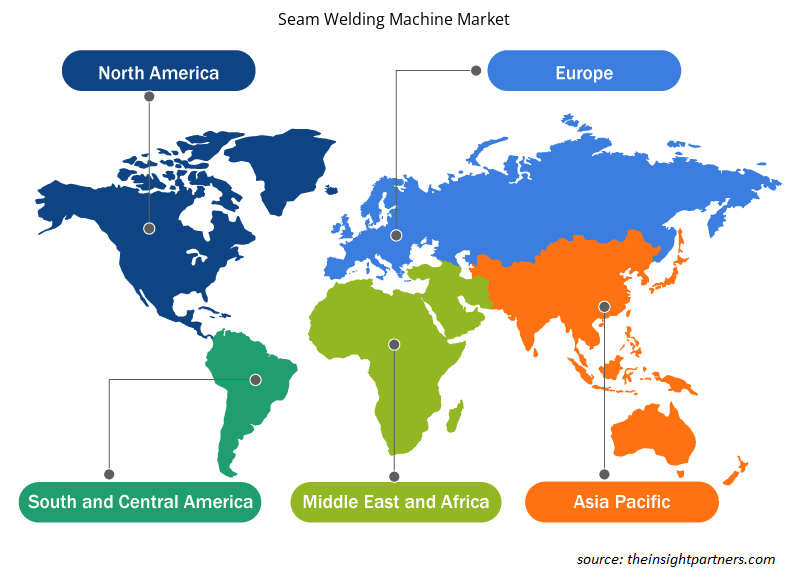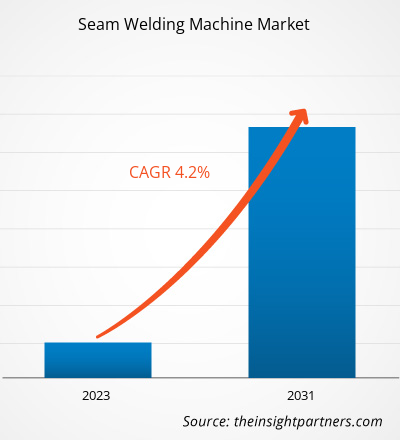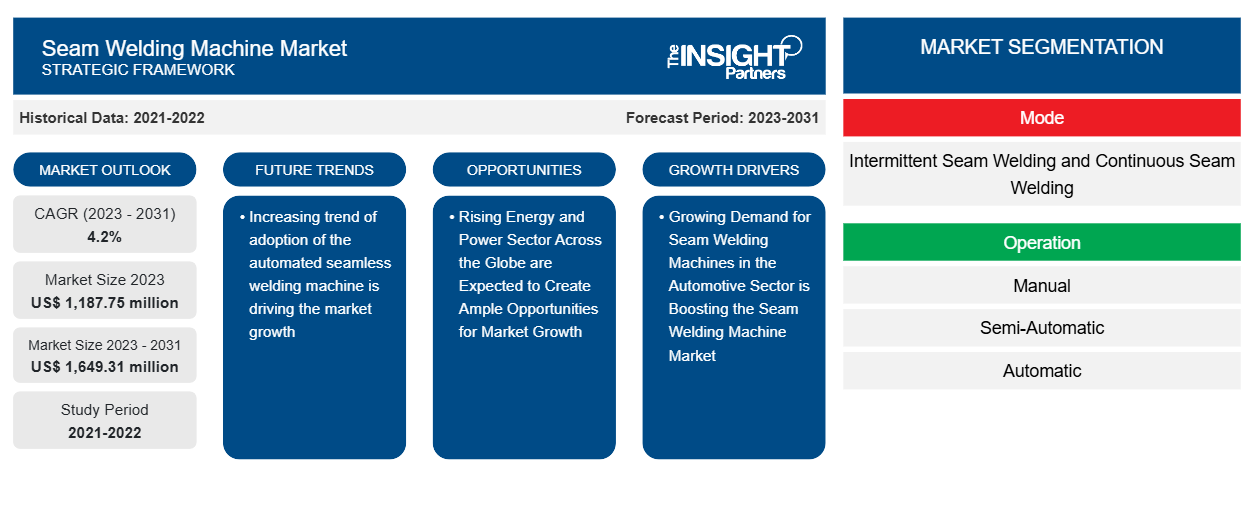Der Markt für Rollnahtschweißmaschinen soll von 1.187,75 Millionen US-Dollar im Jahr 2023 auf 1.649,31 Millionen US-Dollar im Jahr 2031 anwachsen. Der Markt soll in den Jahren 2023–2031 eine durchschnittliche jährliche Wachstumsrate (CAGR) von 4,2 % verzeichnen. Rollnahtschweißmaschinen bestehen aus einem oder zwei motorgetriebenen Rädern, die eine Reihe überlappender Punktschweißungen an den Stahlblechkomponenten erzeugen, um eine luft- und flüssigkeitsdichte Abdichtung der geschweißten Komponenten zu erreichen. Der nahtlose Strom fließt durch diese Rollenbleche und die geschweißten Komponenten werden zwischen ihnen eingepresst. Die wachsende Nachfrage nach Rollnahtschweißmaschinen in verschiedenen Branchen, darunter Automobilindustrie, Industriefertigung, Bauwesen, Energie und Strom, treibt das Marktwachstum im Prognosezeitraum an.
Nahtschweißmaschine Marktanalyse
Der Markt für Rollnahtschweißmaschinen wird von asiatisch-pazifischen Ländern wie Indien, China, Südkorea, Japan und vielen anderen dominiert. Dies ist auf die steigende Nachfrage der Automobilhersteller in den asiatisch-pazifischen Ländern zurückzuführen, die das Marktwachstum antreibt. Indiens Importe von Autokomponenten erreichten im Jahr 2023 20,3 Milliarden US-Dollar, wobei ein erheblicher Anteil von 30 % aus China stammte. Die indische Regierung fördert die inländische Produktion von Elektrofahrzeugen und treibt damit das Wachstum des Marktes für Rollnahtschweißmaschinen voran.
Passen Sie diesen Bericht Ihren Anforderungen an
Sie erhalten kostenlos individuelle Anpassungen an jedem Bericht, einschließlich Teilen dieses Berichts oder einer Analyse auf Länderebene, eines Excel-Datenpakets sowie tolle Angebote und Rabatte für Start-ups und Universitäten.
- Holen Sie sich die wichtigsten Markttrends aus diesem Bericht.Dieses KOSTENLOSE Beispiel umfasst eine Datenanalyse von Markttrends bis hin zu Schätzungen und Prognosen.
Marktübersicht für Nahtschweißmaschinen
Markttreiber und Chancen für Rollnahtschweißmaschinen
Die wachsende Nachfrage nach Nahtschweißmaschinen im Automobilsektor beflügelt den Markt für Nahtschweißmaschinen
Die Automobilproduktion stieg im Jahr 2022 im Vergleich zu 2023 um 11,5 % und belief sich auf weltweit rund 92 Millionen Einheiten. Der Produktionsanstieg treibt in erster Linie die Nachfrage nach fortschrittlichen Maschinen wie Roboterschweißmaschinen für die nahtlose Herstellung von Automobilteilen durch die führenden Automobilhersteller an. Ein solch schnelles Wachstum der Automobilfahrzeugproduktion in den hochentwickelten Volkswirtschaften weltweit hat das Wachstum des Marktes für Nahtschweißmaschinen im Automobilsektor vorangetrieben. Darüber hinaus gewinnt die steigende Produktion von Elektrofahrzeugen mit dem Aufkommen von Hybridelektrofahrzeugen auf dem Markt für Nahtschweißmaschinen an Popularität.
Der weltweit wachsende Energie- und Stromsektor dürfte reichlich Möglichkeiten für Marktwachstum schaffen
Die steigende Nachfrage nach der Herstellung von Solarpanelständern und Industriekesseln im Energie- und Stromsektor dürfte im Prognosezeitraum reichlich Gelegenheit für das Wachstum des Marktes für Nahtschweißmaschinen schaffen. So starteten Mortenson und Terra-Gen im Januar 2024 das größte Solarpanel- und Energiespeicherprojekt namens Edwards & Sanborn Solar in den USA. Mortenson ist der Beschaffungs-, Engineering- und Baudienstleister für dieses Projekt in den USA. Die Zunahme solcher Projekte auf der ganzen Welt dürfte im Prognosezeitraum reichlich Gelegenheit für das Wachstum des globalen Marktes für Nahtschweißmaschinen schaffen.Mortenson and Terra-Gen launched the largest solar panel and energy storage project named Edwards & Sanborn Solar in the US. Mortenson is the procurement, engineering, and construction service contractor for this project in the US. Increasing such projects across the globe is expected to create ample opportunity for the global seam welding machine market growth during the forecast period.
Segmentierungsanalyse des Marktberichts für Nahtschweißmaschinen
Wichtige Segmente, die zur Ableitung der Marktanalyse für Nahtschweißmaschinen beigetragen haben, sind Modus, Betrieb und Branche.
- Basierend auf der Art ist der Markt in intermittierendes Nahtschweißen und kontinuierliches Nahtschweißen segmentiert. Unter diesen hat das kontinuierliche Nahtschweißen den größten Anteil aufgrund der steigenden Nachfrage in der Automobilproduktion weltweit.
- Basierend auf der Funktionsweise wird der Markt für Rollnahtschweißmaschinen in manuelle, halbautomatische und automatische Maschinen unterteilt.
- Nach Branchen unterteilt sich der Markt in Bauwesen, Automobilindustrie, Öl und Gas, Fertigung und andere. Darunter hat die Automobilindustrie im Jahr 2023 den größten Anteil, was auf die weltweit steigende Automobilproduktion zurückzuführen ist.
Nahtschweißmaschine Marktanteilsanalyse nach Geografie
Der geografische Umfang des Marktberichts für Nahtschweißmaschinen ist hauptsächlich in fünf Regionen unterteilt: Nordamerika, Asien-Pazifik, Europa, Naher Osten und Afrika sowie Südamerika/Süd- und Mittelamerika.
Geografisch ist der Markt für Rollnahtschweißmaschinen hauptsächlich in Nordamerika, Europa, Asien-Pazifik (APAC), den Nahen Osten und Afrika (MEA) sowie Südamerika (SAM) unterteilt. Der Asien-Pazifik-Raum wird voraussichtlich im Jahr 2023 den größten Marktanteil haben und seine Dominanz im Prognosezeitraum wahrscheinlich beibehalten. Darüber hinaus wird der Markt für Rollnahtschweißmaschinen in dieser Region im Prognosezeitraum voraussichtlich die höchste durchschnittliche jährliche Wachstumsrate aufweisen. Dies ist auf die zunehmende Automobilproduktion in den asiatisch-pazifischen Ländern wie China, Japan und Indien zurückzuführen. So planten die indischen Automobilhersteller im Jahr 2023, bis 2028 mehr als 7 Milliarden US-Dollar zu investieren, um ihre lokale Produktion von Automobilkomponenten wie Elektromotoren, Karosserieteilen, Fahrgestellen und vielen anderen zu stärken. Außerdem plante Autoneum im März 2024, seine Produktion in asiatisch-pazifischen Ländern wie China und Indien auszuweiten. Das Unternehmen plante die Eröffnung von zwei neuen Werken in Pune in Westindien und in Changchun in Jilin, China. Die Zunahme derartiger Investitionen im Automobilsektor in den Ländern des asiatisch-pazifischen Raums hat zu einer enormen Nachfrage nach Wachstum auf dem Markt für Rollnahtschweißmaschinen geführt.
Europa wird voraussichtlich im Jahr 2023 den zweitgrößten Anteil am Markt für Rollnahtschweißmaschinen halten. Im Gegensatz dazu wird Deutschland voraussichtlich der dominierende Marktteilnehmer für Rollnahtschweißmaschinen in der Region sein. Europa ist die Heimat führender Automobilhersteller, darunter Mercedes, Volkswagen, Skoda, BMW und Audi. Laut der Abteilung für Wirtschafts-, Wissenschafts- und Lebensqualitätspolitik hatte die COVID-19-Pandemie aufgrund der Schließung von Automobilfabriken von März bis Mai 2020 indirekte Auswirkungen auf über 1,1 Millionen Arbeitsplätze.
Darüber hinaus gingen die Fahrzeugverkäufe in ganz Europa im Jahr 2020 stark zurück, während Erstausrüster (OEMs) weitere Verzögerungen bei der Wiedereröffnung ihrer Montagewerke ankündigten. Neben einem Rückgang der Nachfrage nach Personenkraftwagen und leichten Nutzfahrzeugen führten Störungen der Rohstoffversorgungsketten aufgrund von Beschränkungen des grenzüberschreitenden Warenverkehrs zu Verzögerungen bei der Versorgung mit Ausrüstung, wie z. B. Schweißmaschinen . Die COVID-19-Pandemie und ihre Auswirkungen ermutigten die Fertigungsunternehmen jedoch, ihre Abläufe zu digitalisieren und zu automatisieren, was ihnen ermöglichte, ihre Betriebe Ende 2020 wieder aufzunehmen. Solche Wiederbelebungsbemühungen der Fertigungsunternehmen schaffen zukünftige Wachstumschancen für Anbieter von Rollnahtschweißmaschinen in Europa.
Regionale Einblicke in den Markt für Nahtschweißmaschinen
Die regionalen Trends und Faktoren, die den Markt für Rollnahtschweißmaschinen im Prognosezeitraum beeinflussen, wurden von den Analysten von Insight Partners ausführlich erläutert. In diesem Abschnitt werden auch die Marktsegmente und die Geografie für Rollnahtschweißmaschinen in Nordamerika, Europa, im asiatisch-pazifischen Raum, im Nahen Osten und Afrika sowie in Süd- und Mittelamerika erörtert.

- Erhalten Sie regionale Daten zum Markt für Nahtschweißmaschinen
Umfang des Marktberichts über Nahtschweißmaschinen
| Berichtsattribut | Details |
|---|---|
| Marktgröße im Jahr 2023 | 1.187,75 Millionen US-Dollar |
| Marktgröße bis 2031 | 1.649,31 Millionen US-Dollar |
| Globale CAGR (2023 - 2031) | 4,2 % |
| Historische Daten | 2021-2022 |
| Prognosezeitraum | 2023–2031 |
| Abgedeckte Segmente | Nach Modus
|
| Abgedeckte Regionen und Länder | Nordamerika
|
| Marktführer und wichtige Unternehmensprofile |
|
Marktteilnehmerdichte: Der Einfluss auf die Geschäftsdynamik
Der Markt für Rollnahtschweißmaschinen wächst rasant, angetrieben durch die steigende Nachfrage der Endnutzer aufgrund von Faktoren wie sich entwickelnden Verbraucherpräferenzen, technologischen Fortschritten und einem größeren Bewusstsein für die Vorteile des Produkts. Mit steigender Nachfrage erweitern Unternehmen ihr Angebot, entwickeln Innovationen, um die Bedürfnisse der Verbraucher zu erfüllen, und nutzen neue Trends, was das Marktwachstum weiter ankurbelt.
Die Marktteilnehmerdichte bezieht sich auf die Verteilung von Firmen oder Unternehmen, die in einem bestimmten Markt oder einer bestimmten Branche tätig sind. Sie gibt an, wie viele Wettbewerber (Marktteilnehmer) in einem bestimmten Marktraum im Verhältnis zu seiner Größe oder seinem gesamten Marktwert präsent sind.
Die wichtigsten auf dem Markt für Rollnahtschweißmaschinen tätigen Unternehmen sind:
- Emerson Electric Co.
- Daching Electric Industrial
- FranzanKoike Aronson
- Einschl.
- Leister Technologies
- christopher_schoen
Haftungsausschluss : Die oben aufgeführten Unternehmen sind nicht in einer bestimmten Reihenfolge aufgeführt.

- Überblick über die wichtigsten Akteure auf dem Markt für Nahtschweißmaschinen
Marktnachrichten und aktuelle Entwicklungen zum Rollnahtschweißgerät
Der Markt für Nahtschweißmaschinen wird durch die Erfassung qualitativer und quantitativer Daten nach Primär- und Sekundärforschung bewertet, die wichtige Unternehmensveröffentlichungen, Verbandsdaten und Datenbanken umfasst. Im Folgenden finden Sie eine Liste der Entwicklungen auf dem Markt für Innovationen, Geschäftserweiterungen und Strategien:
- Im Jahr 2022 brachte Stealth, ein weltweit tätiger Hersteller von Performance-Ausrüstung, eine patentierte Nahtschweißtechnologie auf den Markt, die das Nähen überflüssig macht. Das Ergebnis dieser Technologie sind wärmere, robustere und absolut haltbare Nähte für langlebigere Produkte, die Abenteurer vor den härtesten Elementen schützen. (Quelle: Eurofins, Pressemitteilung)
- Im Jahr 2022 brachte Miller Electric ein automatisiertes Hercules-MIG-Schweißsystem mit Einzeldraht und hoher Abscheidung auf den Markt. Das Hercules-Schweißsystem erhöht die Schweißkapazität ohne zusätzliche Kosten für die Schweißzellen. Es handelt sich um eine nahtlose Schweißmaschine mit hohen Abscheidungsraten und einer Produktivitätssteigerung von bis zu 30 %. (Quelle: SGS, Newsletter)
Marktbericht zu Rollnahtschweißmaschinen – Umfang und Ergebnisse
Der Bericht „Marktgröße und Prognose für Nahtschweißmaschinen (2021–2031)“ bietet eine detaillierte Analyse des Marktes, die die folgenden Bereiche abdeckt:
- Marktgröße und Prognose für Nahtschweißmaschinen auf globaler, regionaler und Länderebene für alle wichtigen Marktsegmente, die im Rahmen des Berichts abgedeckt sind
- Marktdynamik wie Treiber, Beschränkungen und wichtige Chancen
- Markttrends für Rollnahtschweißmaschinen
- Detaillierte PEST-Analyse und SWOT-Analyse
- Marktanalyse für Nahtschweißmaschinen, die wichtige Markttrends, globale und regionale Rahmenbedingungen, wichtige Akteure, Vorschriften und aktuelle Marktentwicklungen abdeckt.
- Markt für Nahtschweißmaschinen: Branchenlandschaft und Wettbewerbsanalyse, einschließlich Marktkonzentration, Heatmap-Analyse, prominenten Akteuren und aktuellen Entwicklungen.
- Detaillierte Firmenprofile
- Emerson Electric Co.
- Daching Electric Industrial
- Franzan
- Koike Aronson, Inc.
- Leister Technologies
- Kreuzschweiß
- Miller Schweißmeister
- Schnelldorfer Maschinenbau
- Spiro International
- Historische Analyse (2 Jahre), Basisjahr, Prognose (7 Jahre) mit CAGR
- PEST- und SWOT-Analyse
- Marktgröße Wert/Volumen – Global, Regional, Land
- Branchen- und Wettbewerbslandschaft
- Excel-Datensatz
Aktuelle Berichte
Verwandte Berichte
Erfahrungsberichte
Grund zum Kauf
- Fundierte Entscheidungsfindung
- Marktdynamik verstehen
- Wettbewerbsanalyse
- Kundeneinblicke
- Marktprognosen
- Risikominimierung
- Strategische Planung
- Investitionsbegründung
- Identifizierung neuer Märkte
- Verbesserung von Marketingstrategien
- Steigerung der Betriebseffizienz
- Anpassung an regulatorische Trends





















 Kostenlose Probe anfordern für - Markt für Nahtschweißmaschinen
Kostenlose Probe anfordern für - Markt für Nahtschweißmaschinen